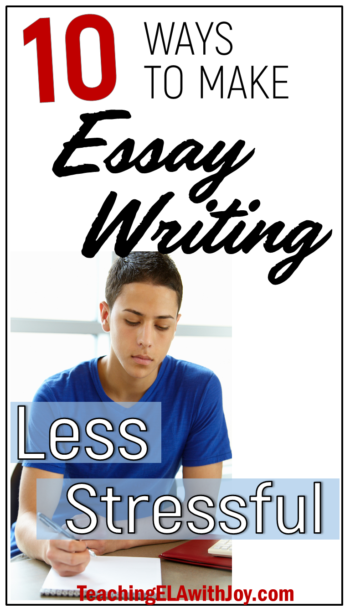 There’s something about the word “essay” that instantly turns the smiles of middle school students into expressions of dread. Of course, we can’t avoid it when the time comes for teaching the essay. But there are some strategies we can use to show our students it’s not as difficult or taxing as they might think. Struggling writers can gain confidence and produce successful writing in a supportive environment with lots of scaffolds and modeling. Here are 10 ways to make essay writing less stressful and more successful for your students:
There’s something about the word “essay” that instantly turns the smiles of middle school students into expressions of dread. Of course, we can’t avoid it when the time comes for teaching the essay. But there are some strategies we can use to show our students it’s not as difficult or taxing as they might think. Struggling writers can gain confidence and produce successful writing in a supportive environment with lots of scaffolds and modeling. Here are 10 ways to make essay writing less stressful and more successful for your students:
-
Keep it Classwork
Have you ever assigned a writing piece as homework? (probably, yes) Then you most likely know that stronger writing happens in the classroom, not at home. Students who are expected to write formal essays need to be writing with you, the expert, on hand, as well as other writers. The expression “a community of writers” is a valuable one that should describe your classroom climate during the essay-writing process. Lead your student writers through the steps, model the requirements, check their progress, and allow them to interact with peers in ways that give them additional support and boost confidence. As they venture into the assignment, assure your students you’ll be with them throughout the process.
-
Let Students Choose Their Topics
If possible, start with an essay where students can choose their own topics. That way, they have a little of the stress lightened for the initial essay. Let’s say you begin with a How-To (Process) Essay. Each student can choose something he or she is good at or knows how to do. Or you could assign a Descriptive Essay, where students choose a place or experience that stands out in their minds to describe in detail. A Research-Based Essay is also a great opportunity for students to delve into topics they are truly interested in. Whichever essay type you decide to go with, you’ll definitely see more buy-in when students are allowed to choose the topic. Then if your next essay is an assigned topic based on a unit (for instance, The Holocaust), students will be more confident repeating the process.
-
Conduct Frequent Peer Exchange
Throughout the process, build in stops where students exchange their efforts. For example, after drafting the “attention-grabber,” have students share them with a partner or in small groups and get feedback. List three questions on your board for students to respond to, like Does the writing grab your attention (or not)? What part of it makes you want to read more? How can it be improved to better get your attention? You could also let students read a body paragraph or each other’s conclusions after drafting and write feedback in the margin or on a post-it. When students check out the writing of their peers (during the process), they often gain inspiration that helps them strengthen their own writing. Plus, you get students helping students!
-
Showcase Student Successes
Students love a pat on the back when they do something right, and a great student example goes a long way in terms of modeling for the struggling writers. So, if your students are working on introductions or topic sentences, walk around reading from their drafts, and stop when you see a decent one. Praise the writer (be specific about what he or she has done well), and then quietly ask if you may read this wonderful example aloud. I don’t mind interrupting my writers to read a good, strong example and point out its attributes. I notice students who begin erasing because they realize they were on the wrong track. Other kids raise their hands and ask me to check theirs. An “I can” mindset begins to take over the classroom!
-
Provide Detailed Organizers
Wouldn’t it would be great if students could just take their topic and visualize the organizational structure needed for a formal essay? Well, we all know, in most cases, that’s not reality. When providing a graphic organizer, make sure it’s detailed and specific, so students can easily gather ideas and examples in the exact format required for the essay. To prevent frustration, make sure each field contains enough space for students to write in the information. You could also insert some arrows to help students see the “flow” of the paragraphs. Other helps: Remind students that they don’t have to write complete sentences on the organizer—that will come during drafting. Also, check that each student has enough information on the organizer, which is necessary before going on to the drafting.
-
Use Mentor Texts
The philosopher, Seneca, once said, “The road to learning by precept is long, but by example short and effective.” So True! Though it does take extra time, if you can provide a good example of a completed task, students really benefit. They always say it helps. Display the mentor text on your whiteboard right after you go over the directions for the essay. “Here’s what a completed essay might look like! What are some things that we notice right away, before we even read it?” You can do a turn and talk and have a class discussion. Then just read it through for them. They can now visualize the assignment, including the structure, approximate length, and the organization of ideas to support the thesis. When students get into drafting, pass out copies of the mentor text so they can examine it more closely in small groups. They could highlight different parts of the essay (attention grabber, thesis, topic sentences, supporting details, etc.) in different colors. They can also look at language and use of transitions. Students will surely make a transfer of knowledge to their own drafting efforts!
-
Give Out Note-taking Sheets
Ah, middle school students. They are not the most organized creatures on the planet. If the essay requires research with hand-written notes, pass out note-taking sheets with lines where students can take bulleted notes from sources. It’s SO much better than having them take notes on their own notebook paper (rip, tear, crunch). Make a section at the top for students to record the website URL or source title, copy them back-to-back, and have them available during the research periods. They’ll be much easier for students to locate in a shuffle of papers later on.
-
Show Them a Citation Generator
When sourcing is required, why not go the easy route? Show students how to use a reliable citation generator, and have them cut and paste their citations to a blank Word document that will become their Works Cited page. I’ve always seen reliable results from www.bibme.org, but there are plenty of others. If students are working in Google Docs, there’s a built-in citation generator in a drop-down menu. Instead of having to refer to the MLA rules for citing all different types of sources and writing down all that information from each source (ugghhh), the only task will be alphabetizing the entries.
-
Make Paragraph Scribble Diagrams
Students are better able to focus their writing with a blueprint. A paragraph scribble diagram helps them to see the types of sentences they’ll be needing to write for a given paragraph at-a-glance. Let’s think about a body paragraph. We want students to compose a topic sentence and then introduce the first key detail in the next sentence. An additional sentence should follow to support or explain that detail. Depending on the requirements, that process should repeat, leading up to a concluding sentence. Here’s a way to have the paragraph-writing format you need really sink in for the students: Draw a big piece of paper on your whiteboard (or do an anchor chart) and scribble in your topic sentence with a certain color. Then label it off to one side using an arrow. Have students come up and scribble in the rest of the required sentences, one by one, using a different color for each requirement and labeling. It might end up looking something like this:
-
Allow End-Product Sharing Time
Students are generally thrilled when given opportunities to read some of their classmates’ finished products. After the essays have been turned in, reserve 15-20 minutes in your lesson plan where you let students read each other’s ungraded pieces (with a partner or rotate in small groups). Students can give feedback on a post-it or half-sheet. Provide a few sentence starters for them to choose from. Just think of what students can take away in terms of added knowledge, not only from reading and responding to others’ writing, but from the peer feedback on their own pieces. This meaningful step will carry over to upping the confidence level when the next essay is assigned!
Though students don’t always view essay writing as desirable, with some of these steps built into your instruction, they will definitely become more comfortable with the process and ultimately more successful. Just keep an enthusiastic attitude, even if they complain. You’ve definitely got this!
If you’re looking for a comprehensive, step-by-step resource for essay writing, check out my Informative Writing – 5 Informational Essays with Guided Writing Templates. There’s everything you need to teach a Research-Based essay, Compare/Contrast essay, Problem/Solution essay, Descriptive essay, and How-To (Process) essay. You’ll have lots to choose from with the scaffolds students will appreciate, including mentor texts.

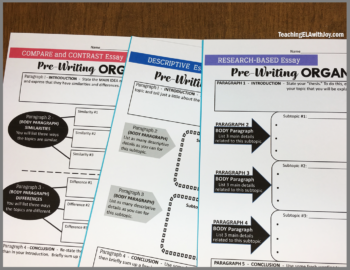
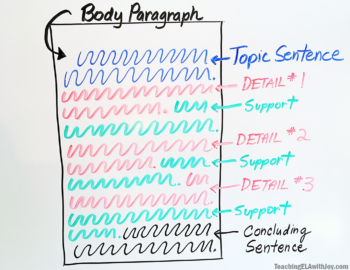
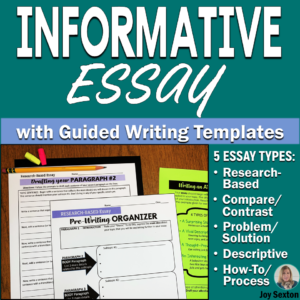
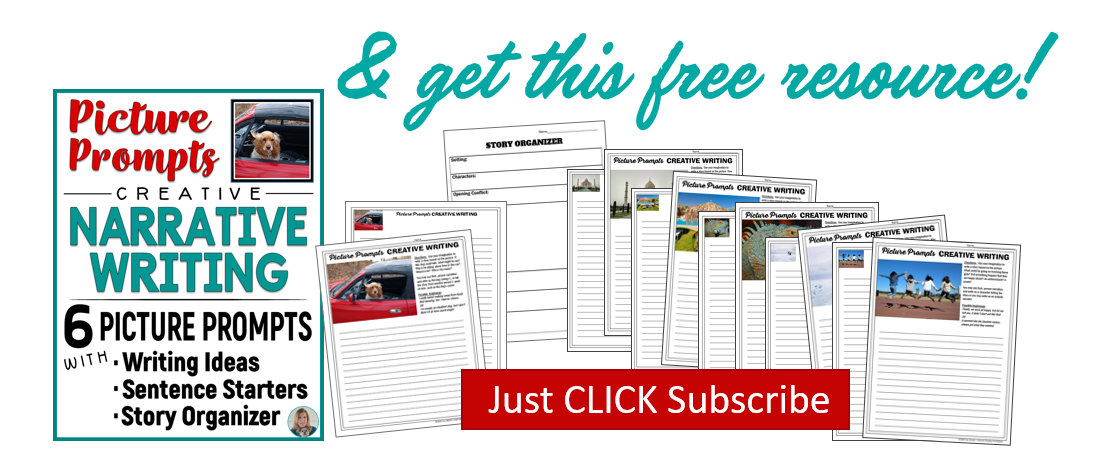


Love your ideas! Yes, 100% to mentor texts! Thank you! 🙂
Thank you for sharing all of your amazing ideas. I am loving your blog!